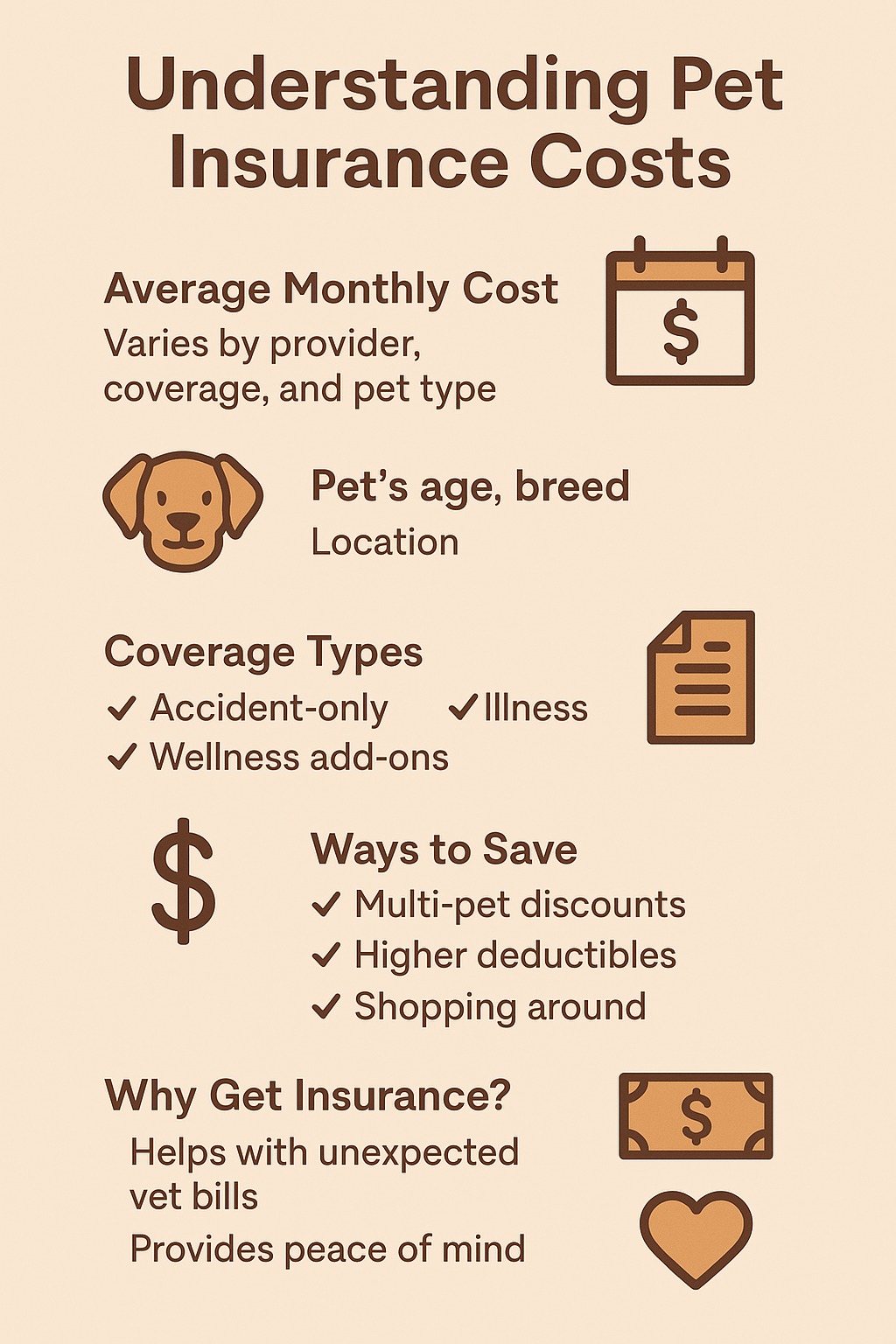Introduction
Pet ownership brings immense joy, but it also entails financial responsibilities, especially when it comes to healthcare for our beloved companions. As veterinary costs continue to rise, many pet owners are considering pet insurance to mitigate unexpected expenses. This guide aims to provide a comprehensive overview of the estimated costs of pet insurance in the United States for the year 2025, along with the key factors that influence these costs and advice on choosing the right plan for individual needs. Understanding these aspects will empower pet owners to make informed decisions about protecting their pets' health and their financial well-being.
Understanding the Real Cost of Pet Insurance in 2025: What You Need to Know
For pet owners seeking a general understanding of the market, several sources provide estimates for the average cost of pet insurance in 2025. According to the North American Pet Health Insurance Association (NAPHIA), the average cost of pet insurance for accident and illness coverage in the U.S. is approximately $56.30 per month for dogs, translating to an annual cost of $675.61. For cats, the average monthly cost is around $31.94, or $383.30 per year.
It's important to note that these are averages, and the actual cost can vary. For instance, MetLife Pet Insurance estimates slightly higher average monthly premiums for 2025, reporting around $60 for dogs and $32 for cats. In contrast, Insurify's data indicates a lower national average of $45 per month for dogs and $24 per month for cats. MoneyGeek's analysis presents an even wider range, with average annual costs of $607.71 for dogs and $299.32 for cats. These discrepancies highlight the fact that average costs can be influenced by the specific methodologies and data sets used by each organization.
To gain a more nuanced understanding of the potential expenses, it is helpful to consider the expected cost ranges. Pawlicy Advisor's 2025 data suggests a monthly range of $37.18 to $72.99 for dogs and $23.84 to $49.76 for cats for accident and illness coverage. These ranges, representing the 25th to 75th percentile of their data, offer a more realistic expectation of what a majority of pet owners might pay. The variability within these ranges underscores that the average cost is not a fixed figure and is subject to several influencing factors.
Key Takeaways: Average Pet Insurance Costs
- Average monthly cost for dogs: $45 - $60 (Accident & Illness)
- Average monthly cost for cats: $24 - $32 (Accident & Illness)
- Costs vary significantly based on the data source
- It's important to consider cost ranges, not just averages
- For a more in-depth look, explore our Pet Insurance Cost Guide

Decoding Pet Insurance Prices: 5 Factors That Skyrocket Your Costs
The price of pet insurance is not uniform and is influenced by a variety of factors, making it essential for pet owners to understand these elements to estimate their potential costs accurately. One of the most fundamental factors is the pet species. Generally, insuring a dog tends to be more expensive than insuring a cat.
This cost difference arises due to several reasons. Dogs, on average, tend to be larger and more active than cats, leading to a higher likelihood of injuries and accidents. Additionally, certain canine breeds are predisposed to specific health conditions that can require costly treatments. The cost of medications and surgical procedures for dogs, often based on weight, can also be higher than for cats.
Another significant determinant of pet insurance costs is the breed of the animal. Different breeds have varying predispositions to certain health issues due to their genetic makeup.
For example, larger dog breeds like Bulldogs, French Bulldogs, Bernese Mountain Dogs, and Great Danes often have higher insurance premiums because they are more prone to conditions such as hip dysplasia, bloat, and respiratory problems. Conversely, smaller breeds and mixed-breed dogs, often perceived as having fewer breed-specific health risks, may have lower premiums. Similarly, for cats, breeds like Maine Coons, British Shorthairs, and Abyssinians can have higher premiums compared to mixed breeds and domestic shorthairs due to their potential for certain hereditary conditions.
Dog Breed and Average Insurance Costs
| Dog Breed | Median Price (Monthly) | Avg. Range (Monthly) |
|---|---|---|
| French Bulldog | $88.68 | $64.36-$114.03 |
| Labrador Retriever | $57.92 | $43.57-$83.06 |
| German Shepherd | $64.86 | $49.67-$82.09 |
| Golden Retriever | $61.11 | $44.21-$84.16 |
| Bulldog | $87.36 | $66.62-$124.08 |
| Beagle | $56.66 | $41.79-$82.94 |
| Poodle | $61.00 | $46.00-$76.00 |
| Chihuahua | $46.18 | $32.96-$63.43 |
| Mixed Breed (Med Dog) | $50.00 | N/A |
For more information on breed-specific insurance costs, especially for breeds like French Bulldogs, see our article on French Bulldog Insurance Costs in NYC and general Dog Insurance Costs
Cat Breed and Average Insurance Costs
| Cat Breed | Average Monthly Premium |
|---|---|
| Maine Coon | $31.00 |
| Domestic Shorthair | $32.00 |
| Ragdoll | $27.00 |
| Persian | $31.00 |
| Abyssinian | $30.00 |
| Mixed Breed (Dom. SH) | $26.00 |
Thinking about getting a dog? Check out our guide on the best dog breeds for first-time owners. Also, we have a feline nutrition guide.
The age of the pet is another critical factor influencing premiums. As pets age, they become more susceptible to various health conditions and the likelihood of needing veterinary care increases. Consequently, insurance premiums generally rise with the pet's age. For example, the monthly premium for a young dog might be significantly lower than for the same dog when it reaches its senior years. Some insurance providers may even have age restrictions for enrolling new pets or might charge substantially higher rates for older animals to offset the increased risk of claims.
Where you live significantly impacts pet insurance costs. The cost of veterinary care can vary considerably across different states and even within the same state, depending on factors like the cost of living and the availability of specialized veterinary services. States with higher costs of living, such as those in the Northeast region, often have more expensive veterinary bills, which in turn leads to higher pet insurance premiums. For instance, New York is frequently cited as one of the more expensive states for pet insurance. Within New York, there can also be regional variations, with premiums in New York City tending to be higher than in more rural areas like Rochester.
Average Monthly Pet Insurance Rates by State: Is Your State Costlier?
| State | Monthly Rate Dog | Monthly Rate Cat |
|---|---|---|
| Alabama | $51.59 | $27.88 |
| Alaska | $56.88 | $32.68 |
| Arizona | $47.93 | $26.94 |
| Arkansas | $51.44 | $29.42 |
| California | $56.96 | $32.58 |
| Colorado | $52.98 | $30.64 |
| Connecticut | $57.27 | $32.90 |
| Delaware | $53.79 | $31.33 |
| Florida | $52.72 | $29.83 |
| New York | $61.35 | $35.12 |
Data from Insurify, February 2025
Finally, the choice of insurer and the specific coverage terms selected by the pet owner will significantly impact the overall cost of pet insurance. Different insurance companies have varying pricing structures, underwriting criteria, and coverage options. Factors such as the deductible amount, the reimbursement rate, and the annual coverage limit chosen by the policyholder will directly affect the premium.
Pet Insurance Plans Compared: Which One Saves You the Most?
Pet owners have several types of insurance plans to choose from, each offering different levels of coverage and varying costs. Accident-only plans provide coverage specifically for unexpected injuries and emergencies resulting from accidents, such as fractures, lacerations, or accidental poisoning. These plans are generally the most affordable option as they do not cover illnesses. In 2025, the average annual cost for an accident-only policy is estimated to be around $204 for dogs (approximately $17 per month) and $116 for cats (about $10 per month). This type of plan can be a budget-friendly way to protect against unforeseen accident-related veterinary expenses.
Accident and illness plans offer more comprehensive coverage by including both accidents and illnesses. These plans typically cover a wide range of medical conditions, from minor infections to major illnesses like cancer or diabetes, as well as injuries. Due to the broader coverage, these plans are more expensive than accident-only policies. The average monthly cost for accident and illness coverage in 2025 is estimated to be between $56 and $60 for dogs and around $32 for cats. This type of plan provides a greater level of financial protection for a wider array of potential health issues.
Wellness plans are designed to cover routine and preventative care services, such as annual check-ups, vaccinations, flea and tick prevention, and dental cleanings. These plans are often available as an add-on to accident and illness policies or sometimes as standalone plans. The average monthly cost for an optional pet wellness plan in 2025 is around $22 to $24 for both cats and dogs. While these plans help manage the costs of routine care, they are not intended to cover unexpected medical expenses.
Why is Pet Insurance So Expensive in NYC? (And How to Save)
Given the specific interest in New York, it is important to examine the estimated costs in this state. As mentioned earlier, New York tends to have higher pet insurance costs compared to the national average. In 2025, the average monthly cost of pet insurance in New York is estimated to be around $58 to $63 for dogs and $32 to $47 for cats. These figures reflect the higher cost of veterinary care in the state.
Furthermore, there are regional cost variations within New York. For instance, Pawlicy Advisor provides examples showing that for a 6-month-old French Bulldog with comprehensive coverage, the monthly premium in New York City could range from $115 to $265, while in Long Island it might be $68 to $195, and in Rochester, $43 to $128. See our article on French Bulldog Insurance Costs in NYC.
Top Pet Insurance Comparison Sites: Find the Best Deal in 2025
To make an informed decision about pet insurance, it is crucial to compare different providers and their plan offerings. Several online resources can assist pet owners in this process. Websites like Pawlicy Advisor, NerdWallet, CNET, Forbes Advisor, MoneyGeek, Pet Insurance Review, and Insurify allow users to compare pet insurance plans side-by-side. These platforms typically enable users to input their pet's information (species, breed, age, location) to receive personalized quotes and compare various aspects of different plans.
These comparison tools often allow users to evaluate plans based on coverage details (including what conditions and treatments are covered and excluded), cost (premiums, deductibles, reimbursement rates, and annual limits), waiting periods before coverage kicks in, customer reviews and ratings to assess the company's service quality, and any available discounts, such as multi-pet discounts. Some platforms, like Pawlicy Advisor, even offer personalized recommendations based on the pet's specific breed and potential health risks, and may provide estimates of the lifetime cost of insurance. When using these resources, pet owners should pay close attention to the specifics of what each policy covers, the associated costs, and the reputation of the insurance provider.
Pet Insurance: Is It Worth the Cost? Your 2025 Decision Guide
Choosing the right pet insurance plan involves carefully assessing individual needs and budget. Pet owners should consider their pet's species, breed, age, and any pre-existing health conditions, as these factors can influence both the likelihood of needing veterinary care and the potential cost of premiums. It is also essential to determine a comfortable monthly premium and to understand the potential out-of-pocket expenses, such as the deductible and co-pays, associated with different plans.
There is a trade-off between the level of coverage and the affordability of the plan.
- Accident-only policies are the most budget-friendly but offer the least comprehensive protection.
- Accident and illness plans provide broader coverage at a higher cost.
- Wellness plans can be a useful addition for routine care but will increase the overall expense.
For younger, healthier pets, an accident-only policy might suffice, while breeds prone to specific health issues or older pets might benefit more from a comprehensive accident and illness plan. Pet owners should also evaluate whether the cost of a wellness plan aligns with their pet's routine care needs and their budget.
Understanding the impact of deductibles, reimbursement rates, and coverage limits is crucial for making an informed decision. Opting for a higher deductible can lower monthly premiums but will require paying more out-of-pocket before the insurance starts to cover expenses. Similarly, the chosen reimbursement rate will affect how much the insurer pays back on a claim after the deductible is met. Pet owners should also ensure that the annual coverage limits are sufficient to cover potential high-cost veterinary treatments.
Is Pet Insurance Right for You? The Ultimate Checklist
Ask yourself these questions:
- Can you comfortably afford a sudden vet bill of $1,000, $5,000, or more?
- Does your pet's breed have a higher risk of specific health problems?
- Are you concerned about the rising cost of veterinary care?
If you answered "no" to the first question or "yes" to the other two, pet insurance is worth seriously considering.
Ready to Find the Best Rate?
Use our Pet Insurance Calculator to get personalized estimates and compare plans.
Your Top Pet Insurance Questions Answered
FAQ: Pet Insurance Costs
How much does pet insurance cost on average?
Why is dog insurance generally more expensive than cat insurance?
Does pet insurance cover pre-existing conditions?
How can I lower my pet insurance premiums?
Are wellness plans worth the cost?
Does pet insurance cost more for certain dog breeds?
How does my location affect pet insurance costs?
What does pet insurance typically cover?
Conclusion: Is Pet Insurance Worth It in 2025?
The estimated cost of pet insurance in 2025 varies significantly based on several factors, with national averages for accident and illness coverage ranging from approximately $45 to $60 per month for dogs and $24 to $32 per month for cats. However, individual premiums can be much higher or lower depending on the pet's species, breed, age, and geographical location, with states like New York often experiencing higher costs.
The type of insurance plan chosen (accident-only, accident and illness, or wellness) and the specific coverage terms also play a crucial role in determining the final premium. By utilizing online comparison resources and carefully assessing their individual needs and budget, pet owners can navigate the pet insurance market and find a plan that provides financial security and peace of mind for their beloved companions in 2025.


